Proposal for a Better Big Ten Schedule

Can you name all the Michigan players in this photo from the last Purdue-Michigan game in Ann Arbor? [photo: a much younger Eric Upchurch]
Since going to 14 teams the Big Ten schedule has been a mess. Some teams rarely face each other, other teams face each other twice a season. The divisions are historically and presently uneven. The last two years in a row this resulted in a Big Ten “champion” that had a demonstrably worse season than at least two other Big Ten teams. Congrats Penn State and Michigan State, but I think we can do better. In fact I have an idea how.
I’ll get into the details below but the idea isn’t for everyone to have to memorize the details. The simplest description is every year you play three locked-in rivalry games, three games of your choosing, and three games against schools near you in the standings. Your biggest rivalry is played at the end of the season, and its result (half) carries over to next season.
On FiveThirtyEight’s Solution: Nate Silver’s proposal and mine share a few concepts: locked in rivalries early in the year, a mini-playoff at the end of the year, and eradicating divisions (which is essential to any good schedule reform). But it has two big flaws I tried to avoid:
1) It puts The Game in September, which: no, or in Week 7, which again: no, and then you’re seeding with less information.
2) Teams at the top will rarely face those at the bottom. I don’t like that because it cuts down on variety and could easily lead to things like long droughts between Michigan-Purdue tilts which are one of the things we’re trying to fix. Also it’s not good for the long term health of the conference since it would redistribute more losses from the bottom of the conference to the middle and middle-high. In effect it would result in fewer and lower ranked teams at the top, and fewer bowl-eligible teams from the conference. A few more competitive games is good, but 538’s proposal takes that to an extreme to the detriment of other important considerations.
Goals:
- Maintain the annual rivalries and maximize their importance, keeping the big rival games at the end of the season.
- Play 9 conference games.
- Split up rivalry games so every team has a compelling schedule every year to sell to season ticket holders.
- Produce a fair and least disputable conference champion by playing all or most of the relevant games during the season.
- Play as many competitive games between similarly ranked teams as possible.
- No rematches!
- See a variety of opponents over a 10-year period.
- Encourage Power 5 opponents in non-conference scheduling.
- Be relatively simple.
The system I came up with hit all of these benchmarks to varying degrees (#9 being measured in Kelvin). #5 conflicts with #7 so I left it up to the schools themselves to prioritize between them. As for #9 it’s actually complicated, but can have the appearance of simplicity.
The schedule has four components:
- Three locked-in games versus your annual rivals.
- Three games where the top teams draft their opponents.
- Three games where you play like competition, and the top four teams all play each other.
- A “Big Ten Showcase” invitational during conf championship week to play the best three games that weren’t played.
DIVISIONS
This is the easy part. The teams are all separated into four pods of three or four with rivals they ought to be playing every year.
| Grp | Big Two, Little Bro | East Coast Cable Subscribers | Intercollegiate Conference of Maladroit Representatives | Corn Corn Corn Corn Cheese Corn Corn Corn |
|---|---|---|---|---|
| A | Michigan | Rutgers | Illinois | Wisconsin |
| B | Ohio State | Maryland | Northwestern | Minnesota |
| C | Michigan State | Penn State | Indiana | Iowa |
| D | x | x | Purdue | Nebraska |
The division names are not important but the order is—if you want a clue as to why, look at the A-B and C-D matchups. Teams in your pod are the two or three teams you play every year. There are two ways to handle the three-team pods and I haven’t decided which I like better—either works about the same:
- Option 1: Lock in rivals. Each team gets an annual rival from the opposite division, e.g. Michigan-Maryland is played the week of OSU-MSU, PSU-OSU always comes when Michigan plays State, and Rutgers-Michigan State is played annually on the last week of the season for bragging rights and the Situation Trophy.
- Option 2: Rotate every 2 years. So after two seasons of the above, Michigan plays Rutgers on week 1, Ohio State plays Maryland, and the Land Grant Trophy becomes the end-of-year rivalry for MSU. Then after two years it becomes M-PSU, OSU-Rutgers, MSU-Maryland.
I sorta prefer Option 1 but Option 2 seems more feasible.
[HIT THE JUMP to see how I worked it all out]
HOME & AWAY
This looks a little complicated but the gist of it is that every year your school’s season ticket package will include either two rivalry games at home, or one rival and five conference games.
| Week | Group A | Group B | Group C | Group D |
|---|---|---|---|---|
| 1 | Home vs C | Home vs D | Road vs A | Road vs B |
| 2 | Road vs C | Road vs D | Home vs A | Home vs B |
| 3-5 | 1/3 home | 2/3 home | 1/3 home | 2/3 home |
| 6-8 | 1/3 home | 2/3 home | 1/3 home | 2/3 home |
| 9 | Home vs B | Road vs A | Home vs D | Road vs C |
These flip every year. Fans will be able to buy season tickets knowing when and where the rivalry games will be played, and how many home games they’ll have in the meat of the schedule.
Ideally they’d know the dates of all of their home and road games beforehand, so a Michigan fan living in New York can plan a buddies weekend on, say, Week 6 knowing there will at least be a competitive game.
START THE CONFERENCE SEASON WITH 2 RIVALRY GAMES
These games are pre-scheduled and played every year on the opening two weekends for the conference. They never change, so you can always count on Michigan-Michigan State being at X venue on Y week. The first week Team A hosts Team D, and Team B hosts Team C. The two team A’s who don’t have a game play each other. The second week Team A plays at C and Team B plays at D. So here’s how that looks for our example 2017 season:
| Week 1 | Week 2 |
|---|---|
| Mich. St. @ Ohio St. | Michigan @ Mich St. |
| PSU @ Rutgers | Rutgers @ Maryland |
| Nebraska @ Wisconsin | Wisconsin @ Iowa |
| Iowa @ Minnesota | Minnesota @ Nebraska |
| Purdue @ Illinois | Illinois @ Indiana |
| Indiana @ Northwestern | Northwestern @ Purdue |
| Maryland @ Michigan | Ohio State @ Penn State |
So far simple enough. It’s still September and we’ve gotten some annual rivalries out of the way. We also have every team with 2 games played: a home and a road.
When to play this is up in the air. There’s an argument to make these games start in mid-to-late September so teams can get themselves geared up for conference season, as it’s always been. On the other hand since we’re determining the next part of the schedule later I think it’s best to play these games starting Week 2 of the regular season.
DRAFT OPPONENTS FOR WEEKS 3-5
If Michigan-Minnesota want more Jug dates they can prioritize that. [Patrick Barron]
To make the schedule for the next three weeks, we let the highest-ranked teams choose their own opponents. First we need to seed them, which I do thusly:
- +2 points for every conference win this year
- -2 points for every conference loss this year
- +1 point for winning last year’s big rivalry game.*
- +1 point per victory over power 5 team this year
- Tiebreakers: 1) head to head, 2) current AP rank 3) wins over P5 schools, 4) wins versus FBS, 5) points scored/points allowed vs FBS**
----------------------------------
* [Yes, the result of The Game last year counts for this year’s conference record. I’ll get into why I did this later on.]
** [Since we’re into unranked teams by this point running up the score is not so much a concern.]
----------------------------------
The first two teams pick their three opponents. The next two teams pick two opponents. Then 5 and 6 pick one opponent each, and the conference fills in the rest. When choosing opponents there are rules:
- No rematches. Can’t take a team they already played or a final week rival.
- Can’t choose a team ranked directly behind them (so the #1 team can’t take the #2 team at home and take away the #2 team’s right to choose their 3 opponents).
- Must respect Home/Away splits (so for example if a Group B team already has a road game scheduled you can’t schedule them for a road slot).
The opponent draft will be held, ideally, on Sunday or Monday of the week prior to the week the next round of games will be played, so fans will have most of two weeks to make their travel plans.
Why an opponent draft? Mostly because this way there’s some flexibility. Rather than leaving it up to the conference to juggle everyone’s needs (rivalries, homecoming, distance, draw, time since we last played, better opponents, easier ones, etc.) the schools themselves get some measure of control over their conference scheduling.
Giving the leading schools their pick of opponents gives more flexibility and lets fans have some input on who they play, for example Ohio State fans could push their athletic department to schedule Illinois if they haven’t played them very often in order to get the Illibuck Trophy back. Michigan might choose to schedule a game at Northwestern or Rutgers because they can knock out a road game and count on their fans to create a home atmosphere at those venues.
Let’s go back to our pretend 2017. Yellow means a team won their Week 1 or 2 game with said opponent, blue means they lost. Purple are the drafted matchups.
Undefeated Penn State was ranked higher than Wisconsin, and chose the easiest route with their two home games and one road, visiting Purdue and hosting Minnesota and Michigan State (they couldn’t take Rutgers since they already played). Wisconsin did the same, going to Purdue and Rutgers and hosting Illinois.
Michigan, held back by last year’s loss in The Game, is seeded 3rd, so we got two spots to fill, choosing to face arch-rival Illinois at home and, under immense pressure from Greg Dooley, taking Minnesota for their other road game. We wanted Northwestern but couldn’t choose them because they’re ranked directly below—Northwestern wanted no part of us, riding their easy early season schedule to an easier middle of the schedule with tilts at Minnesota and a visit from Rutgers. Ohio State opted for the Illibuck game in Week 4. Iowa chose Purdue. The conference filled in the rest.
Those games are announced, and then played, and everyone is re-seeded.
At this point we have a general idea of who’s in contention for the Big Ten crown and who isn’t. It’s time to punch your weight.
Note: I think this idea is cool and adds to the interest of a season, but it also can be done away with and replaced with pre-scheduled rotating games against the 10 teams you’re not locked into playing every year.
SEED OPPONENTS FOR WEEKS 6-8
This time there’s no draft—it’s seeded by the conference with the best teams playing each other and then working on down. First, any games between the top four league leaders that haven’t been played (or won’t be later) are locked in like so: Week 6 is 1v4 and 2v3, Week 7 it’s 1v3 and 2v4, and in Week 8 it’s 1v2 and 3v4.
The remaining empty spots are each filled, top-down, with the hardest opponent still available, with the higher ranked team getting the home game if they have one available.
For our example, I showed these mini-playoff games in salmon:
We now have a complete Big Ten schedule.
END THE SEASON VERSUS YOUR BIG RIVAL
The Game. Paul Bunyan’s Axe. The Oaken Bucket. The Situation Trophy. Whatever Illinois and Northwestern play for now. Something they came up with for Iowa-Nebraska. Penn State versus how stupid “Unrivaled” sounds. The BIG games! They’re all held the weekend before Thanksgiving.
You know, when the students are still in town, assholes.
And they are big, not just because they’ll determine your final seeding this year, but because you’re going to have to live with the result all next year as a +1 or –1 modifier on your conference record.
Let’s sim this out now and see where we stand. Remember scoring is +/- for last year’s rivalry game, +2 per win, –2 per loss, and +1 per non-conference Power 5 win.
So the winner of the Game takes the top spot in the conference. No need for conference championship games.
NO WE NEED MORE MONEY PLAY A CHAMPIONSHIP GAME
Interdivisional championship games are dumb. What the end of the season should be used for is to play the best games that weren’t played all year. If I had my druthers, I’d say get the Pac 12 to play the same kind of schedule then play our champions against each other in the Rose Bowl.
But for plausibility’s sake let’s say the Big Ten is going alone. I’d suggest then that we have a three-game showcase where we play the best three games of the year that weren’t played.
PREFERRED OPTION: Play in the higher seed’s home stadium.
REALISTIC OPTION: Rent out some NFL stadiums. If we’re going this route, let the top teams, in order, choose from the available venues, be they Ford Field, Indianapolis, Minnesota, Green Bay, whatever. Most plausible system would be to put two games in Indianapolis or Detroit, and one in the other, with the first two “hosts” having their pick.
Back to our simulated season to see who didn’t play whom:
The best team Michigan didn’t play is #6 Nebraska. Ohio State missed #5 Northwestern. Wisconsin skipped #4 Maryland. Let’s play those the week after Thanksgiving, again with 2 points going to victors and –2 to losers. Those left out also get –2 points. Trust me, it’s fair. You could also award 4 points to the victors and nothing to losers—it’s literally the same difference.
Huskers have to visit Ford Field, Ohio State makes Northwestern travel to Indianapolis, and Maryland upsets Wisconsin in Indy. End of Big Ten season.
HOW DID WE DO?
Let’s check in on the goals:
1. Maintain the annual rivalries and maximize their importance, keeping the big rival games at the end of the season.
✔ The rivalry games all get played in predictable weeks, with the biggest rivalries haunting you all next year as effectively half a game in the conference standings.
2. Play 9 conference games.
✔ Plus we snuck in a 10th for 6/14 teams.
3. Split up rivalry games so every team has a compelling schedule every year to sell to season ticket holders.
✔ The divisions were organized to put your biggest rival in Week 9, your next rival in Week 2, and that team you happen to share a region with in Week 1, so your top two rivals are never both home or away any given year.
4. Produce a fair and least disputable conference champion by playing all or most of the relevant games during the season, and play as many competitive games between similarly ranked teams as possible.
✔ The mix of the middling in Weeks 3-5 and the mini-playoff at the end made sure that the closer you got to the Big Ten crown, the harder your schedule was likely to get, producing a champion who’d already faced any other contender. Adding half-wins for last year’s rivalry game and power 5 opponents added information to produce far fewer ties. The best team that either Michigan or Ohio State didn’t play was #8 Iowa.
The winner of this was Northwestern, who got to skip Wisconsin and Maryland while playing two easy rivals to start the seeding, but that ultimately earned the Wildcats a visit from Michigan, and trips to Penn State and Ohio State.
5. No rematches!
✔ We made a rule.
6. See a variety of opponents over a 10-year period.
✔-minus. The pick-your-poison round provides an opportunity to schedule teams and head to venues that fans haven’t seen recently, if their schools so desire. Over time the top teams will miss the middle tier unless they choose to schedule them. That might be a good thing—is that 8th win for Iowa or 9th loss for Purdue more important to those respective teams?
7. Encourage Power 5 opponents in non-conference scheduling.
✔ Scheduling more P5 competition is incentivized by making those victories part of the conference formula. That doesn’t differentiate between Alabama or Vanderbilt but you don’t really want Big Ten teams playing Alabama outside of the playoff. There are no points to lose if you don’t win except in AP poll tiebreakers.
8. Be relatively simple.
Fail. This is a long article. But I think most people could behind “9 games: 3 vs rivals, 3 vs your choice, and 3 vs someone your own size, and your biggest rivalry counts for half a game next year.”
The draft portion should create a little bit more engagement. Also the teams are still going to be ordered by conference record—the difference between 8-2 and 7-3 is four points, so to make up that difference a team would need to have beaten its big rival last year and have three Power 5 wins in the non-conference portion AND have a head-to-head win or be ranked higher. At that point it makes sense.
OTHER PROBLEMS INHERENT IN THE SYSTEM HELP HELP MICHIGAN STATE IS BEING REPRESSED
I told you, we’re an anarcho-syndicalist commune.
There are some issues.
Michigan State has to start 0-2 every year. By locking in rivalries early in the year you’ll end up seeing a lot of the same teams drafting. If Northwestern beat Illinois the previous year and can get past Indiana and Purdue, they’ll usually be in a position to choose their opponents. By contrast Michigan State would have to defeat Ohio State and Michigan to ever pick whom they play. Hopefully it’s some consolation that a game with Rutgers is worth extra. Also catching their 5-star-recruitin’, high-turnover rivals earlier in the season should be an advantage a good MSU team would be in position to use. This isn’t a problem.
Fans don’t know who/when they’re playing. While the rivalry games are known far out in advance, imagine trying to plan a homecoming game in there. I tried having specific weeks be home/away ahead of time but it severely cuts down on the matchups you can offer/create in weeks 3-8. But we can have soft home dates (subject to change), where matchups get shuffled around after they’re made in order to fit each team’s home/road schedule.
Last year’s Game affecting this year? On one hand college football is about continuity and rivals, so making a rivalry game hang around your neck for another year is right in line with how things should be. But I get that wiping the slate clean every summer is part of the game. Ultimately this was the way to preserve the higher importance of end-of-the-year rivalries versus the rest of the schedule, but I acknowledge there’s something wrong with that.
Something else I didn’t think of? You tell me.
February 9th, 2017 at 1:50 PM ^
To me, this seems like a Big Ten problem. Nobody in the Big 12 was complaining when the South was dominating their Conference Title game. The SEC didn't complain when the East was dominating, and haven't been complaining now that the West is winning.
Why do we have to "fix" everything?
(and what was wrong with 2015? You had 12-0 Iowa against 11-1 MSU, in a 16-13 game, seems pretty good to me)
February 9th, 2017 at 12:49 PM ^
This is way more complicated than the method 538 talked about a few weeks back, and does not appear to create a better schedule. What am I missing?
Worst idea since a 6 team playoff.
February 9th, 2017 at 1:09 PM ^
You mean the playoff that a review of seasons since the beginning of the BCS era said would be most likely to include all NC contenders while discluding non-contenders?
February 9th, 2017 at 1:18 PM ^
It's better than 4, because it's more teams. It's dumb because it awards a bye for an arbitrary poll result (a huge reward for getting #2 vs #3, which are historically hard to reasonably distinguish). There is no good reason to not have 8 teams, if you're going to expand it.
Anyway it was snark to bring it up, because I just find the hardcore love affair with a lopsided torunament bracket among the admins here kind of funny.
February 9th, 2017 at 2:48 PM ^
is less difficult to distinquish than any cutoff besides #1 vs #2. As you move toward the meat of the bell curve, the differences between teams shrinks. #8 vs #9 is marginally harder to distinguish than #6 vs #7 which are both harder to determine than #2 vs. #3. Your argument is invalid.
The reason not to have 8 is that it diminishes the regular season even further. That is the tradeoff for adding teams. You can make the playoff "better" i.e. more games, but for instance, this season's Michigan-OSU game would have essentially been meaningless to chances of winning a title if there was an 8 team playoff. It probably wouldn't happen in that particular game since it's a rivalry, but if there's another late season matchup between top 5 teams, why wouldn't teams rest players for the playoff like NFL teams that have already clinched do? When you can have a full loss as margin for error, it diminishes the regular season. I'm not saying a bigger playoff wouldn't outweigh the downsides, but an argument certainly can be made that more is not necessariy merrier with a playoff.
With a 6 team playoff, the stakes are still there because the loser would have risked being left out, the winner would have improved chances of getting that first round bye (which dramatically improves chances of a title).
February 9th, 2017 at 4:12 PM ^
They only way to convince me a 6 team playoff is worth it is if you take the P5 championship game winners and then the highest rated non championship game winner. That preserves conference championship integrity as well as giving a close runner up or a non p5 team a chance to compete.
So going into the 2016 college football post season you'd have the following seeds
1. Alabama
2. Clemson
3. Washington
4. Penn State
5. Oklahoma
6. Ohio State
Michigan is the first team out but we were third in our division behind PSU and OSU so not much of an argument to get in over the team that just beat us and Wisconsin is the second team left out but they lost the Championship game to PSU so no dice for them.
2015 would look like this
1. Clemson
2. Alabama
3. Michigan State
4. Oklahoma
5. Stanford
6. Iowa
First team left out would be OSU and you could make a legit argument that they should be in over Iowa, but that is how the comittee decided to rank them and Iowa did have an extra win. Either way this is probably the biggest snub out of the 3 years listed. Notre Dame is the second team left out but they were 10-2 with losses to Clemson and Stanford already so no dice for them.
2014 would look like this
1. Alabama
2. Oregon
3. FSU
4. OSU
5. Baylor
6. TCU
First team left out is 10-2 Mississippi State but they have 2 losses and everyone that made the playoff has 1 or less, and the second team left out is 10-2 Michigan State who already lost to Oregon and OSU so no dice.
February 9th, 2017 at 5:22 PM ^
Except as we showed this year, Conference Championships are stupid. They throw out non-conference games, and often generate champions who just happened to win a bad division but clearly played a worse season than other competition.
Michigan and Ohio State both emerged from the Big Ten with stronger claims to be in the playoff than the Big Ten champ, and there have been many champions with way worse resumes than Penn State's last year. You don't want to ruin the national championship by leaving out schools because conferences made arbitrary division choices and throw out vital information. You don't want a season where Notre Dame is just an exhibition.
February 9th, 2017 at 11:35 PM ^
I strongly disagree that Michigan had a stronger claim to be in the playoff than PSU. Same number of losses, but PSU had an extra win, the conference championship. Some might disagree but there is value in that conference championship.
Now for the flukey championship game results that you are so concerned about... that is why you have the 6th spot for the team that might not have won a conference championship but still has a strong resume.
I know we are all Michigan fans but damn do we cling to strong Septembers when we have miserable Novembers. What does Harbaugh always say? Championships are won in November. What was our record in November? 2-2. That isn't championship football.
February 9th, 2017 at 7:24 PM ^
The difficulty deciding between #2 and #3 is why we went from 2 teams to 4 in the first place - don't tell me they are easy to distinguish!
February 9th, 2017 at 7:49 PM ^
February 9th, 2017 at 12:52 PM ^
At the end of the day geographic splits are the way to go. If you start trying to pick and choose to reach parity it just ends up in a charlie foxtrot. Teams rise and fall from year to year and decade to decade. Just look at PSU and MSU from this year.
ACC has unbalanced divisions as FSU, Clemson, and Louisville are all in the same one. They don't have a geographic split so it makes even less sense. Tell me who is in the Coastal and who is in the Atlantic. I'll be impressed if you know without looking it up.
The SEC West is dominant over the East but before Saban and Miles it was the other way around. The old Big 12 North was horrible compared to the Big 12 South.
At the end of the day the recipe is simple, win your games and beat your rivals. The fact is that we haven't been doing that well recently so trying to tweak the conference schedule to make it easier for us is meaningless.
*rant over
February 9th, 2017 at 12:52 PM ^
Uh, this system doesn't care if you're good historically.
February 9th, 2017 at 12:55 PM ^
Neither does geographic split.
February 9th, 2017 at 1:06 PM ^
But Geographic doesn't care how good you are THIS YEAR. And that's kind of important. Every year we have these travesties where one Big Ten title contender didn't play any of the others, a West team emerges that was already beaten by all the East contenders, or head-to-head vagaries leave out the best teams. And rematches. UNGH. Rematches should be flat-out banned by the NCAA entirely. Plus teams from the opposite division rarely see each other--Michigan plays Rutgers and Maryland EVERY DAMN YEAR, to the detriment of games with far nearer historic enemies like Illinois, Wisconsin, Northwestern, and Purdue, not to mention the Little Brown Jug rivalry.
Fuck regional divisions--all they do is force us to play more games we have less interest in watching.
February 9th, 2017 at 1:21 PM ^
If you hate rematches so much then the Wisconsin vs PSU championship game this year should have made you very happy because it wasn't a rematch.
And you don't know how good you are this year until the year is over...
Even the NFL doesn't do mid season schedule changing. If you want to have the crossover games set aside so one is reserved for a team you haven't played in the longest time and one is a parity game based on how you finished, i.e. in 2017 the 2016 east #3 plays the 2016 west #3 I'm all ears. But midseason scheduling is chaotic. Yeah Maryland and Rutgers suck, but they are in the big ten now and we better get used to it. Nothing short of the entire cable TV industry imploding will get them kicked out of the conference.
February 9th, 2017 at 12:53 PM ^
why not just ship Rutgers and Maryland back to wherever they came from and play a round-robin 11 game sched with one non-con game...boom, Bob's your uncle.
February 9th, 2017 at 12:53 PM ^
And just drop the lowest vote-getting school or two out of the conference. Much easier
February 9th, 2017 at 12:53 PM ^
From left to right -
Ricky Barnum - Kelvin (I think?) Grady - Mark Huyge - Denard Robinson - Taylor Lewan - Patrick Omameh
February 9th, 2017 at 12:57 PM ^
Freshman Funchess, yeah?
February 9th, 2017 at 3:21 PM ^
I think it's Grady, because the numbers on the helmets was a 2011 thing, and MICH 36 - Purdue 14 was 2011. The terrifyingly good Funchess didn't show up until 2012.
February 9th, 2017 at 12:54 PM ^
Shouldn't be a problem to make this happen, especially considering (i) his reputation for innovation, and (ii) how receptive he is to ideas originating from Michigan folks.
February 9th, 2017 at 12:56 PM ^
STEP 1 - kick out Penn State, Nebraska, Maryland, Buttgers
STEP 2 - play a nine-game conference schedule
STEP 3 - profit
February 9th, 2017 at 1:01 PM ^
I motion we keep Nebraska and kick out MSU.
February 9th, 2017 at 1:30 PM ^
Kicking out Staee would essentially render them a directional school. But "Central Michigan" is already taken. Given the geography, I propose "Even More Central Michigan".
February 9th, 2017 at 2:00 PM ^
Mt. Pleasant is closer to the center of the state than East Lansing is. How about "Less Central Michigan" or "Central Michigan South".
February 9th, 2017 at 12:57 PM ^
February 9th, 2017 at 4:52 PM ^
I doubt this will ever happen.
Texas does not want to be an equal partner with its fellow conference members;Texas wants to compensated for the larger number of cable subscribers in its state.
February 9th, 2017 at 10:19 PM ^
February 9th, 2017 at 12:58 PM ^

I smile every time I see that picture, or other references to Holy Grail.
Very few movies make me laugh out loud. The first time I saw Holy Grail I was literally on the floor, clutching my sides, gasping for breath.
"Supreme executive power is derived from a mandate from the masses ... not from some farcical aquatic ceremony!"
February 9th, 2017 at 12:58 PM ^
First fix Drupal, then concure the world. In that order.
February 9th, 2017 at 1:00 PM ^
To quote the great Tom Waits, albeit in a much different context, this is "harder than Chinese algebra".
It's a great thought exercise, but hard to see how this really shakes out in practice. Of course I'd like to see relegation and promotion as a possibility if the P5 grow to more than 18 teams or so (with the relegation records measured over two years - since there are a limited number of games compared with soccer, etc.). Which is probably totally unworkable, but wouldn't it be great to see, e.g., Rutgers v. Purdue really mean something?
February 9th, 2017 at 1:01 PM ^
that an MSU basketball player could understand it. This doesn't pass the test
February 9th, 2017 at 1:07 PM ^
Looks reasonable. Let's see what Delany says to InterM!
February 9th, 2017 at 1:07 PM ^
We've already seen a better version of this from the 538 nerds who did debate or whatever. This is too much, that system was better and achieved the same goals.
February 9th, 2017 at 1:16 PM ^
That system put THE GAME in September. My proposal accomplishes everything they suggested but leaves end-of-the-year rivalry games intact.
The other big problem I had with the 538 proposal is that the middle ends up facing the top but the top and bottom never play each other unless they're rivals. So we end up with a similar problem where Michigan never sees Purdue or Illinois, with an additional problem that teams in the middle end up drawing a lot of games against the top teams and each other. The result would be a lot more teams going 5-7 and missing bowl games. I don't think a few blowouts are a problem, and it's better for the conference as a whole to have more more 6-6 and 7-5 teams.
I should add this to the post.
February 9th, 2017 at 1:24 PM ^
Nevermind
February 9th, 2017 at 2:15 PM ^
I can better appreciate what the new proposal is going for. I'd say that Nate's is trying to identify a conference champion with the most credibility (for entry into the CFP) and all other criteria (except a few rivalry games) are ignored: playing everybody at least occasionally, maximizing conference participation in non-CFP bowl games.
For better or worse, the base response to Nate's proposal would be to schedule only non-conference cupcakes to improve the odds of bowl eligibility. But that sacrifices the new proposal's goal of encouraging Power 5 cross-conference games.
It all comes down to which goals are most important.
February 9th, 2017 at 1:10 PM ^
I prefer a less complicated system of no divisions, 9 game schedule,3 rivalry games played every year, the other six games can be scheduled so that in a four year career you go to every school in the conference, no divisions takes away the wrong champion most of the time. But now that it's legal to not have divisions I don't know why we insist on having them.
February 9th, 2017 at 4:26 PM ^
I'm generally in this camp, except I have fewer rivalry games.
2 rivalry games - 7 non-rivalry conference games and 11 teams non-rival conferemce teams to play. So, on average you'd play non rival teams a little less than 2 times in 3 years. If you want to get fancy, you could try and balance out schedule strength in the spring ahead of the season.
1 rivalry game - 8 non-rivalry conference games and 12 non-rival conference teams to play. So, on average, you'd play non rival teams 2 times in 3 years.
0 rivalry games (oh the heresy!) - 9 conference games and 13 teams to play. On average, play a team more than 2 times in three years. Maybe you could institute some type of system where a limited number of teams are guaranteed to see each other at least 2 times in any three year period, but not every year.
The fewer rivalry games, the easier it is to get to a more evenly balanced strength of schedule.
February 9th, 2017 at 1:11 PM ^
February 9th, 2017 at 3:09 PM ^
See my proposal below.
February 9th, 2017 at 1:11 PM ^
I didn't vote for you.
February 9th, 2017 at 1:19 PM ^
https://fivethirtyeight.com/features/make-college-football-great-again/
Silver has rivals play in weeks 2, 5, 7, but identifying/picking 3 rivals for each team can be tricky.
Weeks 1 and 3 are based on last year's standings. The remaining weeks are power-matched to make sure the better teams have to play each other during the season.
Silver's scheme makes more sense mathematically for determining the conference champion (without a championship game), but besides the flex scheduling (which is an issue for both Silver's and Seth's plans), Silver uses two weeks after the last rivalry game to help sort out the conference champion.
Under Seth, there's a hypothetical where a good but not great team gets to duck the second-best team because the top-rated team gets a lucky rival draw in the last week.
Since there's already a conference championship after the Game, I'm fine with shifting OSU a few weeks if it means that we can get a truer sense of who the champion is.
ETA: Earlier discussion of Silver's proposal
http://mgoblog.com/mgoboard/538-article-how-do-away-conference-title-ga…
February 9th, 2017 at 1:36 PM ^
The biggest differences:
-
His plan uses last year's RECORDS to determine seeding, which could be a big punishment for teams with a significant drop-off. My plan shrinks that to just one game--the big rivalry game at the end of the year.
- His plan creates more games between the top echelon and the middle, while I shifted more of those to Top-Bottom games. I don't think Nate realizes that Michigan never seeing Purdue again is a bad thing, or that Iowa playing Michigan instead of Purdue is a bad thing for conference health.
Ultimately my plan gets the top games played but helps the middle class look a bit better, leading to more Top 25 and bowl-eligible teams while adding losses to non-bowl-eligible teams.
February 9th, 2017 at 1:15 PM ^
February 9th, 2017 at 1:19 PM ^
If you dont know who's playing, you cant or wont make travel plans, at least until the very last minute.,
If you cant or wont make travel plans until the very last minute, you are less likely to come, because a) it's more expensive b) you may already be booked
If you cant or wont make travel plans and in the end don't come, that's bad for the team (because potentially smaller attendance); that's bad for fans (because they don't get the experience), but also you can expect massive resistance from the local econom(ies).
etc etc
February 9th, 2017 at 1:26 PM ^
but I just don't see it happening or being able to work. I really think fans make travel plans more then two weeks out. I ventured out for a game this year and planned it months before it happened.
Honestly with expansion and their being 14 teams the B1G just needs to start scheduling more conference games and let teams know that is a downside of expansion. I really think we should try to do a 10 game conference schedule. It would leave you with only 2 out of conference games, but that's the down side of a 14 team conference.
I know the NCAA occassionally allows teams to play 13 regular season games. If that's the case teams could play 11 conference games with the last one being the weekend after Thanksgiving.
If you play a 10 conference schedule every two years you rotate to play the 3 teams you haven't played the last two years. You don't even need to split up the conference. Just play 10 games and if you decide to have a conference championship the top 2 teams play in it. Lot's of ways to do tie breakers, like head to head, common opponents, even getting down to point differentail in conference games. Place the teams 1-14 according to their conference record.
February 9th, 2017 at 1:26 PM ^
Have only two non-conference games and ten conference.
February 9th, 2017 at 1:32 PM ^
Michigan's 2 conference losses in 2016 came against teams Penn State didn't even have to play. That's definitely unfair.
MSU in 2015 didn't play either of the 2 "best teams in the conference" at all (much less having to perhaps play one or both of them on the road). That's also definitely unfair.
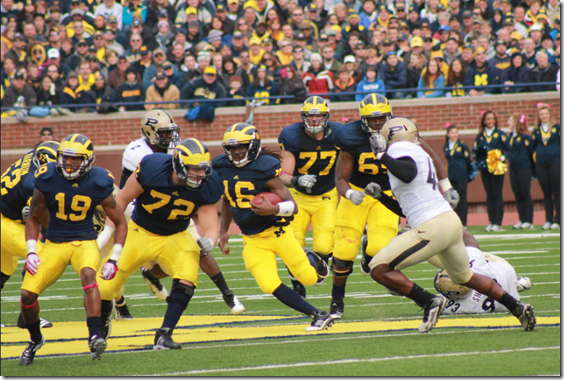
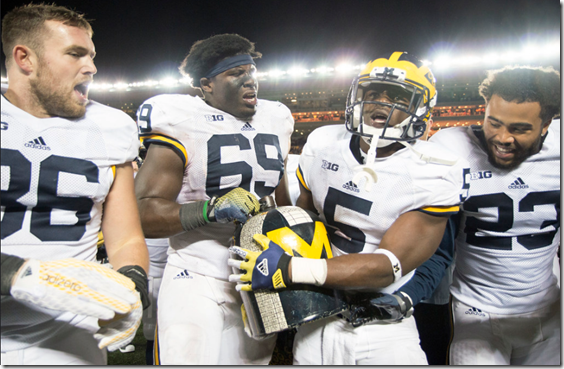

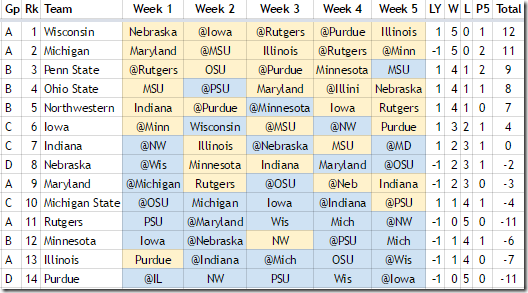
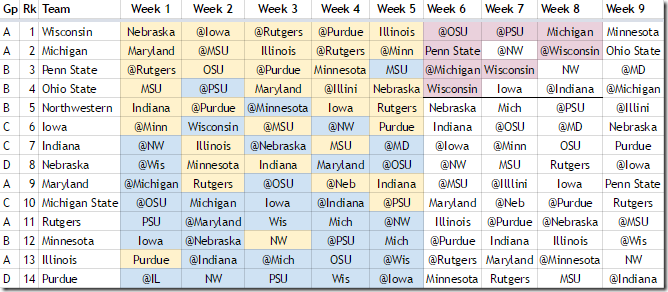
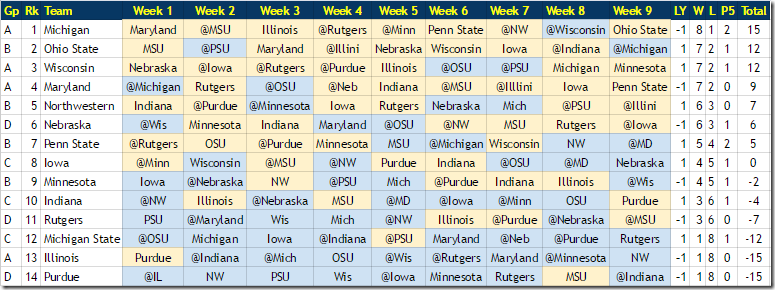
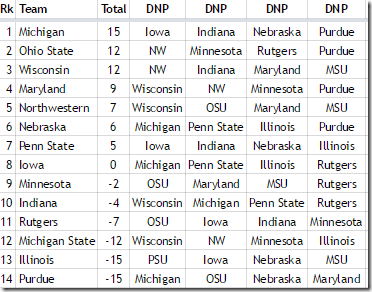
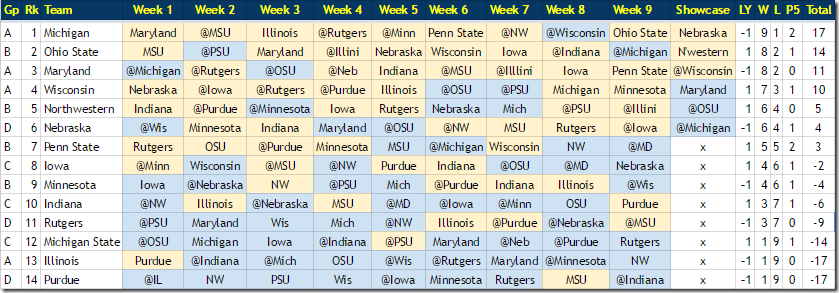
Comments